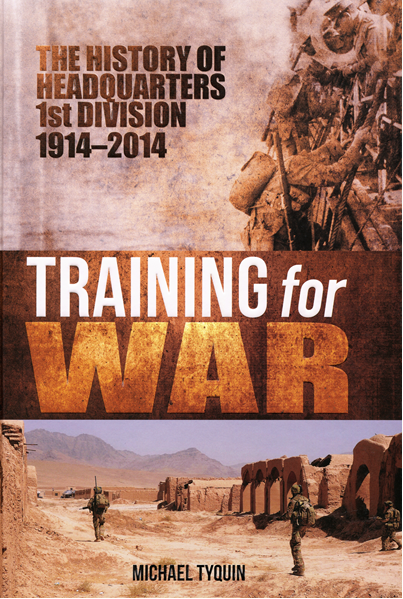Training for War examines the history of Headquarters 1st Division. The 1st Division was first formed in 1914 for service during World War I as a part of the Australian Imperial Force (AIF). It was initially part of the Australian and New Zealand Army Corps (ANZAC) and served with that formation during the Gallipoli campaign. The division later served on the Western Front where its main battles include Pozières, Mouquet Farm, Bullecourt, Third Ypres, Menin Road, Broodseinde Ridge, Second Passchendaele, Hazebrouck, Second Somme and the Hindenburg Line.

After the war, the Division became a reserve formation based in New South Wales (NSW) and during World War II it undertook defensive duties in Australia before being disbanded in 1945. Re-raised in 1960 to command all Army units in NSW under the Pentropic structure the Headquarters was re-tasked in 1965 to certify the operational readiness of units deploying to Vietnam until 1972.
In late 1973 the Division was re-formed as a full division based in Queensland. The division grew into a formation of over 13,000 personnel, which, at its peak in the early 2000s, consisted of four brigades: two Regular, one integrated and one Reserve spread across Queensland, NSW and the Northern Territory.
In 1997, the Headquarters was given the additional task of deploying a Deployable Joint Force Headquarters (DJFHQ) to command Army, Royal Australian Air Force and Royal Australian Navy assets during large-scale operations. In 1999 and 2000, the Headquarters – as well as many of its subordinate units – deployed to East Timor and acted as the headquarters of the joint and multi-national International Force in East Timor (INTERFET) with Major General Peter Cosgrove commanding.
Following the establishment of Forces Command in 2009, the combat units assigned to the Headquarters 1st Division were re-assigned to Forces Command. The Headquarters was once again tasked with certifying Army units for operational deployments in addition to maintaining the DJFHQ capability.
Thus, over the space of 100 years the Headquarters of the 1st Division has existed in a number of different forms and performed a variety of roles. They each have a place in this story as do many distinguished Australians who have had a close association with the Division, either commanding it or holding senior positions there.
Training for War looks at the organisation’s high water mark in World War I as well as quieter times between the world wars, before the tempo picks up again in the period closer to our own time. As with any military formation it cannot be studied in isolation from politics and policy and so reference is made to wider events in the Australian political and defence environment.
Tyquin is an historian who has published extensively in the areas of Australian social, medical and military history. He is a serving member of the Australian Army Reserve and the official historian of the Royal Australian Army Medical Corps. Tyquin is also an adjunct professor at the University of Queensland’s Centre for Military and Veterans’ Health.
Training for War includes 67 photographs, tables and illustrations, as well as 10 full-colour maps embedded through the text. Seven appendices provide short biographies of all the Division’s commanders and Victoria Cross recipients, as well as key events, orders of battle, photographs of headquarters buildings, and other items of historical interest. A detailed bibliography, endnotes and a comprehensive index make this book a useful reference piece.
Training for War is an important contribution to the historiography of the Australian Army and an interesting case study in the evolution of military organisations.
Contact Marcus Fielding about this article.






